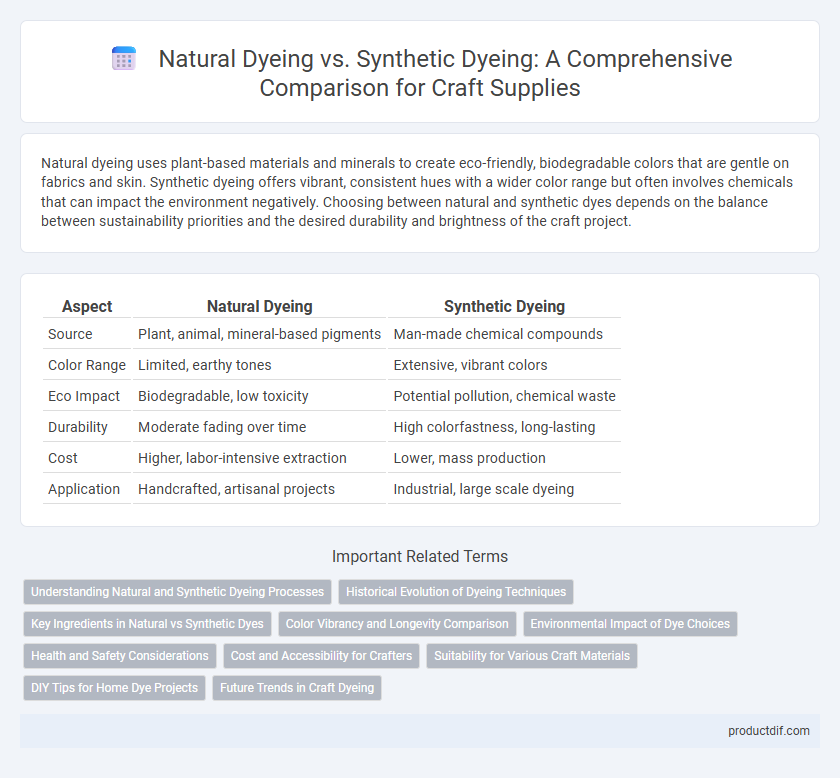Natural dyeing uses plant-based materials and minerals to create eco-friendly, biodegradable colors that are gentle on fabrics and skin. Synthetic dyeing offers vibrant, consistent hues with a wider color range but often involves chemicals that can impact the environment negatively. Choosing between natural and synthetic dyes depends on the balance between sustainability priorities and the desired durability and brightness of the craft project.
Table of Comparison
| Aspect | Natural Dyeing | Synthetic Dyeing |
|---|---|---|
| Source | Plant, animal, mineral-based pigments | Man-made chemical compounds |
| Color Range | Limited, earthy tones | Extensive, vibrant colors |
| Eco Impact | Biodegradable, low toxicity | Potential pollution, chemical waste |
| Durability | Moderate fading over time | High colorfastness, long-lasting |
| Cost | Higher, labor-intensive extraction | Lower, mass production |
| Application | Handcrafted, artisanal projects | Industrial, large scale dyeing |
Understanding Natural and Synthetic Dyeing Processes
Natural dyeing utilizes pigments extracted from plants, minerals, and insects, offering eco-friendly and biodegradable colorants with unique, variable hues. Synthetic dyeing involves chemically engineered dyes derived from petrochemicals, providing consistent, vibrant colors with superior colorfastness and a broader spectrum. Understanding these processes highlights the balance between sustainability and performance when selecting dyes for craft projects.
Historical Evolution of Dyeing Techniques
Natural dyeing has roots tracing back to ancient civilizations such as Egypt, India, and China, where plant-based and mineral pigments were extracted for fabric coloring. The Industrial Revolution introduced synthetic dyeing in the mid-19th century, revolutionizing textile production with chemically derived dyes offering vibrant colors and consistent results. Over time, synthetic dyes dominated due to cost-efficiency and scalability, yet recent trends show a resurgence in natural dyeing driven by environmental and sustainability concerns in the craft supply industry.
Key Ingredients in Natural vs Synthetic Dyes
Natural dyeing relies on key ingredients such as plant extracts, roots, bark, leaves, and insects, which provide eco-friendly and biodegradable colorants. Synthetic dyeing uses chemically engineered compounds like azo, anthraquinone, and indigo dyes, offering a wider color spectrum and greater consistency in fabric application. The choice between natural and synthetic dyes impacts environmental sustainability, colorfastness, and potential allergenicity in craft supplies.
Color Vibrancy and Longevity Comparison
Natural dyeing produces rich, earthy tones with moderate color vibrancy that often fade gracefully over time, appealing to eco-conscious crafters seeking authenticity. Synthetic dyeing delivers intense, vibrant hues with superior colorfastness and longevity, maintaining brightness after repeated washes and prolonged exposure to sunlight. Craft supply enthusiasts prioritize synthetic dyes for projects requiring lasting color impact, while natural dyes remain favored for sustainable, artisanal creations.
Environmental Impact of Dye Choices
Natural dyeing uses plant-based dyes that biodegrade easily and reduce water pollution, making it an eco-friendly choice compared to synthetic dyeing. Synthetic dyes often release toxic chemicals and heavy metals into waterways, contributing to environmental degradation and health hazards. Choosing natural dyes supports sustainable crafting by minimizing harmful waste and preserving ecosystems.
Health and Safety Considerations
Natural dyeing uses plant-based pigments that are generally non-toxic and biodegradable, reducing exposure to harmful chemicals and environmental hazards. Synthetic dyeing often involves chemical compounds that can cause skin irritation, respiratory issues, and require proper ventilation and protective equipment to ensure safety. Choosing natural dyes supports a safer crafting environment by minimizing health risks associated with chemical dyes.
Cost and Accessibility for Crafters
Natural dyeing often involves higher initial costs due to sourcing organic materials like plants, roots, and insects, but offers sustainable and unique color variations valued by eco-conscious crafters. Synthetic dyeing provides more affordable and readily accessible options, with consistent color results and widespread availability in craft stores and online marketplaces. Crafters balancing budget and sustainability frequently choose synthetic dyes for cost-effectiveness while those prioritizing natural aesthetics invest in potentially more expensive natural dye supplies.
Suitability for Various Craft Materials
Natural dyeing offers excellent compatibility with natural fibers such as cotton, silk, and wool, preserving the fabric's texture and breathability while providing earthy, muted tones. Synthetic dyeing excels in versatility, delivering vibrant, consistent colors across a wide range of materials including synthetics like polyester and nylon that natural dyes cannot effectively color. Craft artisans select dye types based on material composition, desired colorfastness, and environmental considerations, making the choice crucial for achieving optimal results in handmade projects.
DIY Tips for Home Dye Projects
Natural dyeing uses plant-based materials like indigo, turmeric, and onion skins, offering eco-friendly and non-toxic options ideal for DIY home dye projects. Synthetic dyeing provides vibrant, long-lasting colors with consistent results but often involves chemical components that require safety precautions during use. For successful home dyeing, pre-wash fabrics, use mordants with natural dyes to fix colors, and always test colorfastness on small fabric samples before full application.
Future Trends in Craft Dyeing
Future trends in craft dyeing emphasize sustainable practices, with natural dyeing gaining momentum due to increasing environmental awareness and demand for eco-friendly materials. Innovations in natural dye extraction and fixation techniques improve colorfastness and expand the palette, while synthetic dyes continue evolving with safer, non-toxic formulas to reduce ecological impact. Hybrid approaches combining natural and synthetic elements are emerging, reflecting a shift towards balancing tradition, performance, and sustainability in craft supply markets.
Natural Dyeing vs Synthetic Dyeing Infographic

 productdif.com
productdif.com